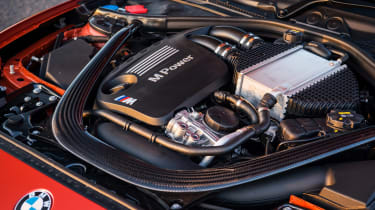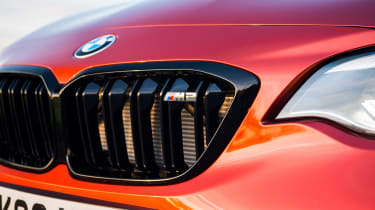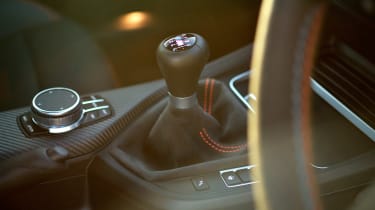F87 BMW M2 (2015-2021) review – ride and handling
The last of its generation, the M2 is a throwback to a golden age of small, rear-wheel-drive performance models from Munich
The F22-generation 2-series coupe was been totally reworked to create the F87 M2., It’s 8mm lower, the front track is 58mm wider, the rear is 45mm wider and wheelbase is 3mm longer. The F82 M4’s front and rear aluminium suspension is carried over to the M2, and the rear axle remains solidly mounted just as on bigger M car. On top of this little lot the Competition added strut and bulkhead braces from the M4, plus stiffer ball joints in place of the old rubber bushes in the rear axle.
The M2’s ride is firm, and the early cars came without switchable dampers, so it was firm all the time. On rough UK roads there are times you wish for a little more compliancy, but the upside is that where the old 1M's rear axle felt slightly wayward, on all M2s it was better tied down. It’s only on the worst roads that the M2 can start get a little frisky, the short wheelbase causing the car to pitch around a little. This was improved with the arrival of the CS, which not only added adjustable dampers, but also made the whole suite of variable powertrain and chassis modes individually selectable – something we take for granted in modern BMW M models.
More reviews
Group tests
- BMW M3 CS v Litchfield BMW M2: which makes the better track car?
- BMW 230i M Sport v Volkswagen Golf GTI Clubsport
In-depth reviews
Long term tests
Reviews
Strengthening the bodywork delivered it improvements, with the M2 having a similarly direct and grippy front axle as the M4. In combination with the recalibrated ESP and MDM electronically controlled rear differential it endows the Competition with a nimbleness that its bigger brother can’t match, the M2 swivelling around your hips in time with inputs to the steering.
> Read our review of AC Schnitzer’s ACL2
As a result the M2 is imbued with a flow that is most impressive, allowing you to easily and confidently generate a rhythm when driving quickly. The chassis, grip, engine, diff and steering all added up to create such an intuitive driving experience.
If you judge your speed well and brake late into a corner, you can start to feel the car want to rotate simply on turn-in. It doesn’t break traction, or even transition into oversteer, but you get a sense of how nimble the M2 is.
Once you’ve experienced that slight rotation you can get on the throttle and use the acceleration to help you round the rest of the corner, the throttle directly influencing your line. The engine’s vast amounts of torque mean that the rear tyres, that already seem to be close to their limits, are easily overwhelmed.
Once the rear wheels have started to spin, the engine’s response and linear delivery means the rear is easy to control. You can regain grip with a small lift, maintain a nice neat slide around the corner with a fairly constant throttle, or add more throttle for a bigger slide.
There’s a minimal amount of roll, especially at the rear. This lack of body roll adds to your confidence in the M2, you never have to wait for the body to respond it’s instantly there with you. It also means that weight transfer is small, and so recovering from a slide is neat and satisfying.
Thanks to such a transparent chassis, you can keep the M2 near its limits corner after corner. There’s not a lot of feedback from the steering, but that’s not a problem as you can easily judge the car’s limits from the clear information transmitted through the suspension.
The M2 is shod with Michelin Pilot Super Sports, a lot of how controllable the car is, can be attributed to these tyres and how well the chassis and drivetrain has been developed to work with them. The way the rear remains controllable and adjustable, even once the tyres have broken traction, just adds to your confidence in the M2 even more.
In the wet, the M2 still doesn’t behave like a scary, wild, turbocharged, rear-wheel drive car that you might expect it to. Its limits are lower and some understeer is more detectable, but it’s not particularly pronounced and is easily quelled with a good jab of the throttle.
On the manual car, the throttle automatically blips for every down-change. It’s very competent, and matches the revs perfectly without fault. However, if you’ve spent your driving career trying to perfect the art of the heel-and-toe, you’ll still want to do it yourself. The only way to turn off this function is to turn off all of the traction aids.
If you’re used to an F80 M3 or F82 M4, turning off the traction control completely is a daunting prospect; you need to be brave and alert. It’s different in the M2 though, because despite the short wheelbase, the handling is more predictable and the engine offers much more control.
> BMW M2 CS revealed to rival Porsche Cayman GT4
In fact, with the traction control left on (even in its more relaxed MDM state) it feels less of a safety net and more of a frustration. If you choose to reach an angle of slide that is just a touch too great, the computer kills all the fun immediately. If you do prefer the added security of some traction control, and you don’t attempt too large a slide, the MDM still allows for some fun – even if you do have to make do with the auto blip downshifts.
There is no carbon ceramic brake option for the M2, and on the road that is perfectly fine as the cast iron units never seem to get too hot. On track it's a different story, with the stoppers starting to groan and grumble in complaint after several hot laps, although the stopping power itself remains fairly strong.
That is until you misjudge your speed, even by a fraction. To scrub off enough speed you then have to press the brake pedal beyond the sensitive top fraction and the car doesn’t continue to decelerate at the same pace. All that’s required to rectify this is a harder press of the pedal, and you do so. But, the moment where the brakes aren’t with you, although brief, is just long enough to make your heart skip a beat.
On track the M2 is feisty, wanting to oversteer almost everywhere. Stringing together a neat lap isn’t easy, but it is fun and demanding trying to do so.
If you feel tempted to modify your M2 there are plenty of options, one of which includes BMW’s own in-house M Performance range of parts. They don’t add any extra power or torque, but a set of height adjustable coilovers allows you to change the height and stance of the car. Amazingly, the new springs and dampers barely change the car’s behavior.
Renowned BMW tuner, AC Schnitzer, offers more power as well as chassis upgrades, but the results aren’t dramatic. It’s certainly not as intense as AC Schnitzer’s wild ACL2, a thoroughly modified M235i with the twin-turbo engine from the M4 with 503bhp.
The M2 has the poise that a great BMW M car should have. It might not possess the same sort of aggression as its bigger siblings, but because of that it’s more controllable, more predictable and, ultimately, even more fun car to drive quickly.






